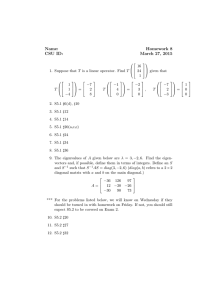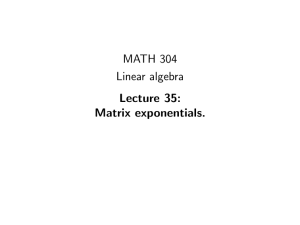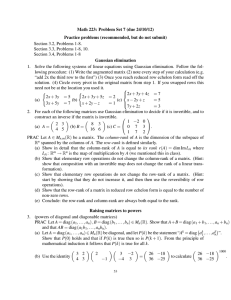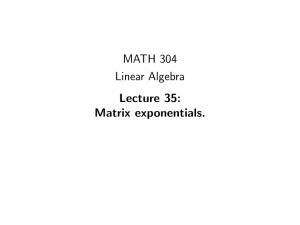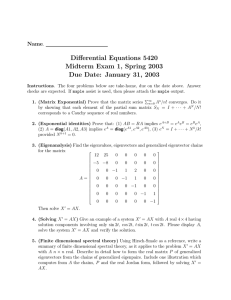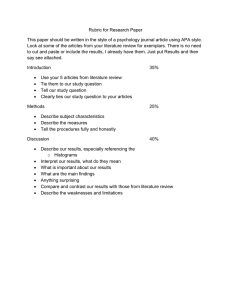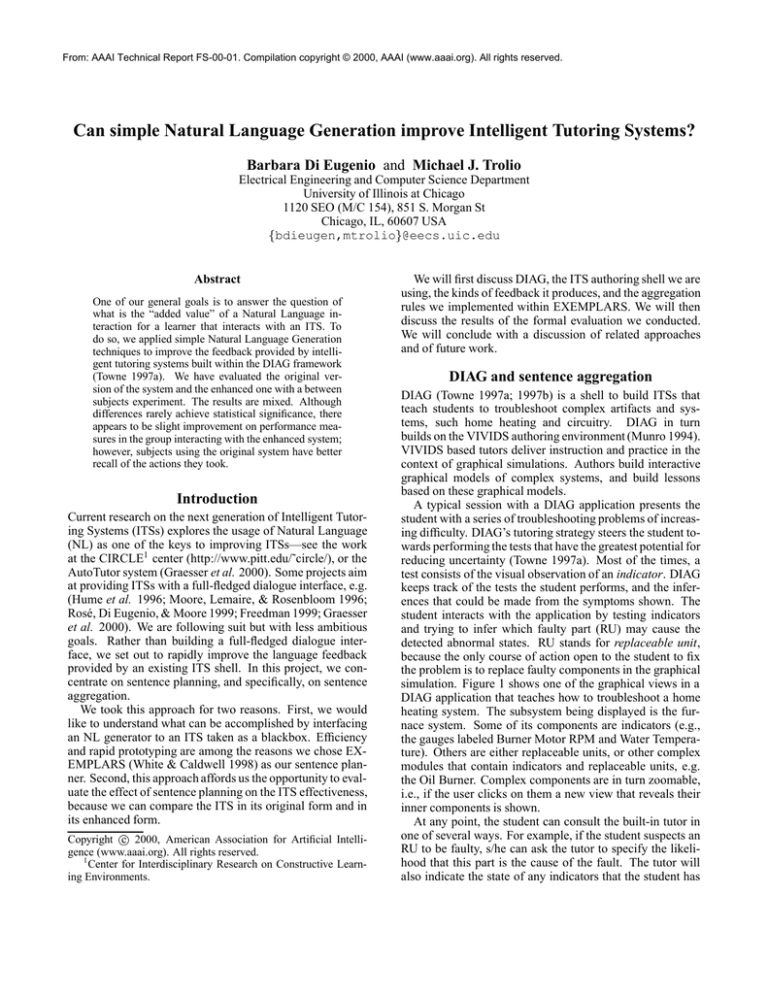
From: AAAI Technical Report FS-00-01. Compilation copyright © 2000, AAAI (www.aaai.org). All rights reserved.
Can simple Natural Language Generation improve Intelligent Tutoring Systems?
Barbara Di Eugenio and Michael J. Trolio
Electrical Engineering and Computer Science Department
University of Illinois at Chicago
1120 SEO (M/C 154), 851 S. Morgan St
Chicago, IL, 60607 USA
fbdieugen,mtroliog@eecs.uic.edu
Abstract
One of our general goals is to answer the question of
what is the “added value” of a Natural Language interaction for a learner that interacts with an ITS. To
do so, we applied simple Natural Language Generation
techniques to improve the feedback provided by intelligent tutoring systems built within the DIAG framework
(Towne 1997a). We have evaluated the original version of the system and the enhanced one with a between
subjects experiment. The results are mixed. Although
differences rarely achieve statistical significance, there
appears to be slight improvement on performance measures in the group interacting with the enhanced system;
however, subjects using the original system have better
recall of the actions they took.
Introduction
Current research on the next generation of Intelligent Tutoring Systems (ITSs) explores the usage of Natural Language
(NL) as one of the keys to improving ITSs—see the work
at the CIRCLE1 center (http://www.pitt.edu/˜circle/), or the
AutoTutor system (Graesser et al. 2000). Some projects aim
at providing ITSs with a full-fledged dialogue interface, e.g.
(Hume et al. 1996; Moore, Lemaire, & Rosenbloom 1996;
Rosé, Di Eugenio, & Moore 1999; Freedman 1999; Graesser
et al. 2000). We are following suit but with less ambitious
goals. Rather than building a full-fledged dialogue interface, we set out to rapidly improve the language feedback
provided by an existing ITS shell. In this project, we concentrate on sentence planning, and specifically, on sentence
aggregation.
We took this approach for two reasons. First, we would
like to understand what can be accomplished by interfacing
an NL generator to an ITS taken as a blackbox. Efficiency
and rapid prototyping are among the reasons we chose EXEMPLARS (White & Caldwell 1998) as our sentence planner. Second, this approach affords us the opportunity to evaluate the effect of sentence planning on the ITS effectiveness,
because we can compare the ITS in its original form and in
its enhanced form.
Copyright c 2000, American Association for Artificial Intelligence (www.aaai.org). All rights reserved.
1
Center for Interdisciplinary Research on Constructive Learning Environments.
We will first discuss DIAG, the ITS authoring shell we are
using, the kinds of feedback it produces, and the aggregation
rules we implemented within EXEMPLARS. We will then
discuss the results of the formal evaluation we conducted.
We will conclude with a discussion of related approaches
and of future work.
DIAG and sentence aggregation
DIAG (Towne 1997a; 1997b) is a shell to build ITSs that
teach students to troubleshoot complex artifacts and systems, such home heating and circuitry. DIAG in turn
builds on the VIVIDS authoring environment (Munro 1994).
VIVIDS based tutors deliver instruction and practice in the
context of graphical simulations. Authors build interactive
graphical models of complex systems, and build lessons
based on these graphical models.
A typical session with a DIAG application presents the
student with a series of troubleshooting problems of increasing difficulty. DIAG’s tutoring strategy steers the student towards performing the tests that have the greatest potential for
reducing uncertainty (Towne 1997a). Most of the times, a
test consists of the visual observation of an indicator. DIAG
keeps track of the tests the student performs, and the inferences that could be made from the symptoms shown. The
student interacts with the application by testing indicators
and trying to infer which faulty part (RU) may cause the
detected abnormal states. RU stands for replaceable unit,
because the only course of action open to the student to fix
the problem is to replace faulty components in the graphical
simulation. Figure 1 shows one of the graphical views in a
DIAG application that teaches how to troubleshoot a home
heating system. The subsystem being displayed is the furnace system. Some of its components are indicators (e.g.,
the gauges labeled Burner Motor RPM and Water Temperature). Others are either replaceable units, or other complex
modules that contain indicators and replaceable units, e.g.
the Oil Burner. Complex components are in turn zoomable,
i.e., if the user clicks on them a new view that reveals their
inner components is shown.
At any point, the student can consult the built-in tutor in
one of several ways. For example, if the student suspects an
RU to be faulty, s/he can ask the tutor to specify the likelihood that this part is the cause of the fault. The tutor will
also indicate the state of any indicators that the student has
Figure 1: A screen from a DIAG application on home heating
explored and try to imply a correlation, positive or negative,
between the states of the indicators to the RU in question.
By utilizing the tutor’s feedback, the student can deduce relationships among the system parts and continually refine
his/her solution.
After deciding which content to communicate, the original DIAG system uses very simple templates to assemble
the text to present to the student. The result is that the feedback that DIAG provides is repetitive, both as a sequence
of replies to requests for feedback, and within each verbal
feedback. In many cases, the feedback presents a single
long list of many parts. This problem is compounded by
the fact that most DIAG applications involve complex systems with many parts. Although there are different levels of
description in the system model, and hierarchies of objects,
the verbal feedback is almost always in terms of individual
indicators or units. The top part of Figure 2 shows the reply originally provided by DIAG to a request of information
regarding the indicator named “Visual Combustion Check”.
We set out to improve on DIAG’s feedback mechanism by
applying aggregation rules. For example, a long list of parts
can be broken down by classifying each of these parts in to
one of several smaller lists and then presenting the student
with this set of lists.
The bottom part of Figure 2 shows our aggregation rules
at work. The revised output groups the parts under discussion by the system modules that contain them (Oil Burner
and Furnace System), and by the likelihood that a certain
RU causes the observed symptoms. Notice how the Ignitor Assembly is singled out in the revised answer. Among
all mentioned units, it is the only one that cannot cause the
symptom. This fact is just lost in the original answer.
DIAG and EXEMPLARS
As our sentence planner, we chose EXEMPLARS (White
& Caldwell 1998) over better known systems such as FUF
(Elhadad 1993) and Penman (Bateman 1994) because of the
complexity and learning curve of the latter two.
EXEMPLARS is an object-oriented, rule based generator. The rules (called exemplars) are similar to schemalike text planning rules because they are meant to capture
an exemplary way of achieving a communicative goal in
a given communicative context, as determined by the system designer. EXEMPLARS is a hybrid system that mixes
template-style and more sophisticated types of text planning.
The text planner selects rules by traversing the exemplar specialization hierarchy. The applicability conditions associated with each exemplar are successively evaluated in or-
Figure 2: Original (top) and revised (bottom) answers provided by DIAG to the same Consult Indicator query
der to find the most specific exemplar for the current context. Because EXEMPLARS rules are schematic templates,
they offer several practical advantages such as simplified
development, runtime decision efficiency, and reduced demands on knowledge acquisition and representation (White
& Caldwell 1998). Additionally, as EXEMPLARS is a fully
object oriented framework, built on top of Java 1.1, it provides the developer with features inherent in object-model
design such as extensibility and decoupling of the text planner from the domain application.
The communication between DIAG and EXEMPLARS
is achieved using VNET communications, a TCP/IP-based
client-server layer that is built into VIVIDS. The DIAG application is the server, and the client is a separate Java-based
application that both communicates across a socket and that
contains the EXEMPLARS rule base and feedback generator. This intercommunication is needed to correctly synchronize the flow of DIAG events.
In a VIVIDS based system, events are packets of procedural code that are activated by external triggering conditions. A student query triggers an event. Within this event,
DIAG collects the information it needs to communicate to
the student. In the original system, all the information is
concatenated in a single string. In the DIAG-NLP system,
this information is written to a text file that is then passed to
EXEMPLARS. The textfile contains one or more packets of
information, structured as follows:
<DIAG event-name> <Indicator|ReplUnit>
<attribute1-name> <attribute1-value>
.
.
.
.
<attributeN-name> <attributeN-value>
A portion of the text file that DIAG passes to EXEMPLARS
for the example in Figure 2 is as follows:
ConsultIndicator Indicator
name Visual combustion check
state igniting
modeName startup
normalState combusting
-- -ConsultIndicator ReplUnit
name Oil Nozzle
fufer always
-- -ConsultIndicator ReplUnit
name Ignitor assembly
fufer no effect
-- -ConsultIndicator ReplUnit
name System Control Module
fufer sometimes
The attribute fufer2 represents the strength of the causal
connection between the failure of an RU and an observed
symptom. The order of the information packets in the text
file mirrors the order in which DIAG assembles the infor2
The name comes from DIAG and its origin is unknown to us.
mation, which is also directly mirrored in the feedback the
original DIAG system provides (see top of Figure 2).
As we had planned, we only minimally modified DIAG.
The lines of code within the event that would generate
strings in the text window are replaced with a call to the
appropriate VNet function. Specifically, we modified four
DIAG events, ConsultIndicator, ConsultReplUnit, ConsultDebrief, ConsultShowSuspRUs. The latter two are invoked
after the subject has solved the problem, to get a “critique”
of their troubleshooting strategy. The latter two are also fully
functional, but as we did not collect metrics about them, we
will not discuss them further.
Based on the message sent by DIAG, EXEMPLARS performs essentially three tasks:
1. it determines the specific exemplars needed;
2. it adds the chosen exemplars to the sentence planner as a
goal;
3. it linearizes and lexicalizes the feedback in its final form,
writing it to an external file.
In our current implementation, EXEMPLARS generates
answers to all queries regarding indicators and RUs. DIAG
still directly generates other textual feedback that did not
appear as problematic, such as the initial statement of the
problem.
EXEMPLARS needs to know the DIAG event that invokes it, but the text file EXEMPLARS receives from DIAG
does not contain any directive regarding how to aggregate
the information and how to format the text. After EXEMPLARS has produced its feedback, it writes it to another text
file. Other code on the client side will trigger the appropriate DIAG event, that reads the new text file and appends it to
the DIAG text window line by line (the text file produced by
EXEMPLARS contains all formatting instructions) — see
the bottom part of Figure 2.
The rule base
The EXEMPLARS rule base being used with the home heating application was designed to be small and flexible. Recall
that in EXEMPLARS rules, i.e., exemplars, are organized in
an inheritance hierarchy. Exemplars inherit methods from
their ancestors. The inheritance hierarchy is used as a decision tree, that the generator traverses until it finds the most
specific rule that can be applied, and passes it to the text
planner.
The rule base consists of description rules and aggregation rules.
Description rules are used when the full description of
a part is required, such as whether the part is in a normal
state, its current reading, and, if abnormal, what the normal
state should be (see the first sentence in the bottom part of
Figure 2). There are four description rules, the generic DescribePart, and its three daughters DescribeIndicator, DescribeReplUnit, DescribeEmptyList. The latter is used to
generate the final clause for the ConsultDebrief event.
The aggregation rules are used to classify large lists of
parts into a set of smaller lists. There are eight rules for aggregation. The topmost is AggByType, which controls nest-
ing of embedded lists. AggByType has 6 daughters, among
them:
AggByContainer: each part within this DIAG application
is contained within a larger block, called a system module.
The AggByContainer rule accepts a list of parts, classifies
each part by its containing module, and then creates a set
of lists by module;
AggByFufer: it groups replaceable units according to the
likelihood of being at fault for a specific symptom;
AggByState: it groups indicators by their normal / abnormal state.
The eighth aggregation related rule, Agg, is not part of this
subhierarchy, but is invoked by the other aggregation rules,
because they do not directly create textual feedback. Agg
can accept a singleton list as well as a regular list. This rule
also deals with formatting, namely, creating vertical lists,
spacing, etc.
Aggregation rules are designed to allow composite aggregation. This has the effect of creating nested lists. As an example, a part can be aggregated by its type (indicator/RU),
and then by its fault likelihood, and finally by its containing
module. This type of composition would appear in the feedback as a three-level nested list. In practice, though, deep
nesting of aggregation rules does not occur, because DIAG
always discusses only one indicator or one replaceable unit
at a time. As demonstrated in the bottom part of Figure 2,
the most frequent application of the aggregation rules is to
group parts according to the system module they belong to,
and within each module, to group replaceable units by how
likely it is they may cause the observed symptom.
To give the reader a rough idea of how often the rules
are invoked, consider the means of event occurrences from
Table 1. In our experiments, there were roughly 6 indicator consultations and 18 RU consultations over 3 problems,
namely, 2 indicator consultations and 6 RU consultations
per problem (i.e., dialogue). Thus, the DescribeIndicator
and DescribeReplUnit rules were invoked 2 and 6 times, respectively; the AggByContainer and Agg exemplars were invoked 6+2=8 times per dialogue.
Note that in this experiment, morphology, lexical realization and referring expression generation were all treated ad
hoc, i.e., they were directly encoded in the appropriate exemplars. We will address some of these problems in future
work, see below.
Evaluation
The contrast between the feedback produced by the original
system and by the DIAG-NLP system (top and bottom in
Figure 2) provides some evidence that even simple aggregation rules dramatically improve the language feedback.
However, to provide a better assessment of this claim, we
conducted an empirical evaluation designed as a betweensubject study. Both groups interact with the same DIAG application that teaches them to troubleshoot a home-heating
system. One group interacts with the original system, the
other group with the system that generates enhanced feedback. For ease of reference, we will call the two groups
DIAG-orig and DIAG-NLP respectively.
Seventeen subjects were tested in each group. Our subject
pool comprised 13 undergraduates, 18 graduates, and 3 research staff, all affiliated with our university. Participation in
the experiment was restricted to science or engineering majors. Each subject first reads some short material about home
heating that we developed. Afterwards, each subject goes
through the first problem as a trial run. Each subject then
continues through the curriculum on his/her own. The curriculum consists of three problems of increasing difficulty.
Subjects are encouraged to interact with DIAG as much as
possible. At the end of the experiment, each subject is administered a questionnaire.
Metrics. Various metrics are tracked while the subject
solves problems. Some of them were originally collected
by DIAG. The original DIAG metrics include: how many
problems the subject solved; time on each problem; how
many replaceable units the subject replaced in each problem;
whether the subject solved the problem or gave up. Among
the metrics we added are: the time a subject spends reading each verbal feedback DIAG provides, and the total time
spent reading feedback; the number of times the subject consults DIAG on indicators and replaceable units, respectively;
which indicators and replaceable units the subject consults
DIAG about, and which RUs the subject replace.
Questionnaire. The questionnaire is divided into three
parts.
1. The first tests the subject’s understanding of the system.
Because the questions asked are fairly open ended, this
part was scored as if grading an essay.
2. The second concerns the subjects’ recall of their actions,
specifically, of the indicators they consulted the system
on and of the RUs they replaced. We did not ask about
consultations about RUs not to make the questionnaire too
long, and because we thought there would be many more
indicator consultations than RU consultations. However,
the opposite is true, see Table 1.
Because we have a detailed log of each subject’s actions,
we can compute measures such as precision and recall.
For each subject, precision is the percentage of correct
answers with respect to the total number of answers a subject gave; whereas recall is the percentage of correct answers they gave with respect to the log of their actions.
Because there are well known trade-offs between high
precision and low recall and vice versa, we also compute
2
PR
the F-measure, ( 2+1)
P +R , that smooths them off: P is precision, R recall, and a parameter that has to be set appropriately (Jurafsky & Martin 2000). As we use = 1,
our F-measure is P2P+RR .
3. The final part of the questionnaire asks the subject to rate
the system’s feedback along four dimensions (see Table 3)
on a scale from 1 to 5.
Results
Every student solved all the problems (DIAG gives them the
option I give up, but nobody used it). Thus, at the level
Time
Feedback Time
# of consultations
# of indicator consultations
# of RU consultations
# of parts replaced
Essay score
DIAG-orig
29.8’
6.9’
30.4
11.4
19.2
3.85
81/100
DIAG-NLP
28.0’
5.4’
24.2
5.9
18.1
3.33
83/100
Table 1: Means of some general measures
Indicator Precision
Indicator Recall
Indicator F-measure
RU Precision
RU Recall
RU F-measure
DIAG-orig
.33
.33
.44
.74
.73
.72
DIAG-NLP
.17
.27
.29
.65
.63
.63
Table 2: Means for precision / recall
of problems solved, there is no difference between the two
groups.
Tables 1, 2, 3 show the results for the measures we computed; the measures in boldface are those that are statistically significant, or at least marginally significant, and they
will be discussed more in detail below. Note that these are
cumulative measures across the three problems; we did compute the same measures for each problem, and the results for
individual problems are similar to the cumulative ones we
discuss here.
On the whole, Tables 1 and 3 show some small differences in favor of DIAG-NLP, although most of them are not
statistically significant. We consider the lower number of
indicator consultations in DIAG-NLP as evidence in favor
of the effectiveness of the aggregated feedback: because the
feedback is better and highlights what is important (such as
that the Ignitor Assembly can never cause the Visual Combustion check to ignite, see Figure 2), the subjects can focus their troubleshooting without asking as many questions
of the system, at least as regards indicators. However, Table 2 shows that subjects in DIAG-orig remember what they
did better than those in DIAG-NLP (recall that the measures
regarding indicators concern the indicators a subject consulted the system about, whereas the measures regarding
RUs concern the RUs the subject replaced). All in all, this is
Usefulness
Helped stay on right track
Not misleading
Conciseness
Average score
DIAG-orig
4.35
4.35
4.00
3.47
4.04
DIAG-NLP
4.47
4.35
4.12
3.76
4.18
Table 3: Means of rating the system feedback
a puzzling result, especially because subjects in DIAG-orig
consult the system on indicators more often than subjects in
DIAG-NLP, thus we would expect them to have more problems remembering what they did. Note that precision and
recall are much higher for RU replacement than for indicator consultations, as would be expected because there are
many more indicator consultations than RU replacements.
Statistical significance of results. Table 4 reports the
measures that have or approach statistical significance in
boldface. For each measure, we report the mean of the distribution, the standard deviation, and the results of several
tests. Two tests (Shapiro-Wilks and Levene) are used to
check whether the assumptions of the t-test are respected:
whether the distribution is normal, and whether the two distributions have the same variance, respectively. The null hypothesis that the distribution is normal and that the variances
are equal are respectively rejected when Shapiro-Wilks and
Levene are statistically significant (p<.05). If the first assumption is not respected, the t-test is not applicable, and a
non-parametric test such as Mann-Whitney can be applied
(we report the results for Mann-Whitney for every measure
anyway). If the variances cannot assumed to be equal, a
variant of the t-test (Welch’s test) can be applied (in practice, the two tests have very similar results even when the
variances are not equal) — in Table 4 the t-test column reports the appropriate kind of t-test, according to the results
of the Levene’s test.
Table 4 shows that only two measures achieve real statistical significance, precision and F-measure, both regarding
indicators. Note however that precision and recall for indicators are very poor for both groups (see Table 2). The measure indicator consultations exhibits a non-significant trend
in the predicted direction. We also report statistics computed
on the log of indicator consultations (taking the log often
makes the distribution normal, as in this case). Both the
t-test and the Mann-Whitney test remain at the same significance level, p=0.11.
Possibly, the most general conclusion to be drawn from
Table 4 is that most of our distributions are not normal and
that their variances are not equal. Regarding the first point,
it is likely to occur because of the small number of subjects.
The difference in variance is in our opinion more interesting.
In the DIAG-NLP group, for almost all measures the standard deviation is lower than for DIAG-orig, in some cases
significantly so, as shown in Table 4. In those few cases (RU
precision, RU recall and RU F-measure) in which the standard deviation for DIAG-NLP is higher than for DIAG-orig,
the difference is at most .02. Although these differences may
be due just to sampling error, they can also be explained by
the fact that a system that allows a more natural interaction
engenders a more homogeneous behavior among subjects.
As mentioned, the two groups are both composed of science or engineering majors. DIAG-orig includes 7 undergraduates, 9 graduates, and one research staff, DIAG-NLP
6 undergraduates, 9 graduates, and 2 research staff.3 One
3
We asked them for their SAT / GRE scores, but as few subjects
provided them, we cannot use these scores to test for differences
Indicator Consultations
Indicator Consultations (log)
Parts Replaced
Indicator Precision
Indicator Recall
Indicator F-measure
Diag-orig
DIAG-NLP
Diag-orig
DIAG-NLP
Diag-orig
DIAG-NLP
Diag-orig
DIAG-NLP
Diag-orig
DIAG-NLP
Diag-orig
DIAG-NLP
Mean
11.4
5.9
.88
.67
3.7
3.3
.33
.17
.67
.52
.44
.29
Std Dev.
11.2
4.0
.41
.32
1.6
0.5
.27
.10
.33
.27
.21
.10
Shapiro-Wilks
.75, p=.01
.91, p=.09
.93, p=.28
.96, p=.59
.48, p=.01
.58, p=.01
.92, p=.23
.95, p=.48
.86, p=.02
.93, p=.25
.95, p=.48
.95, p=.48
Levene
5.47, p=.03
t-test
—
Mann-Whitney
98, p=.11
1.83, p=.19
1.62, p=.11
98, p=.11
4.97, p=0.03
—
135, p=.76
9.35, p=.004
2.19, p=.04
95, p=.09
0.73, p=.40
—
93.5, p=.08
4.33, p=.047
2.51, p=.02
58, p=.08
Table 4: Measures with or approaching statistical significance
confounding variable could be the mastery level of English
on the part of subjects. We set out to test only native or
near-native speakers, but we did not find enough subjects,
so we had to relax this constraint. Thus, we recomputed all
the measures we discussed here on a reduced pool of subjects, 13 in the DIAG-orig group and 15 in the DIAG-NLP
group. Six subjects were eliminated because their English
was judged to be too poor by the experimenter. However,
the results discussed hold across the reduced subject pool as
well.
Related work
There are two areas of research related to the work presented
in this paper: NLG and evaluation of NLG systems, and NL
interfaces to ITSs, and their evaluation.
(Reiter & Dale 1997) define sentence aggregation as the
process of grouping messages together into sentences. They
note that types of sentence aggregation include conjunction, ellipsis, set formation, and embedding. The work we
have described in this paper mainly falls within set formation, like e.g. (Dalianis 1996; Huang & Fiedler 1996;
Shaw 1998). We are not including embedding (Scott &
Sieckenius de Souza 1990; Cheng & Mellish 1997) in our
discussion. For a recent and comprehensive review of work
in aggregation, see (Reape & Mellish 1998).
As (Reiter & Dale 1997) points out, the most difficult aspect of aggregation is to decide which of the numerous potential aggregations should be performed. Our choice was
constrained by relating our aggregation rules to the structure of the domain and the tutoring strategy embodied in the
system in question (DIAG).
The most common problem in all the work on aggregation, including ours so far (but see below), is that aggregation rules and heuristics are plausible, but are not based on
any hard evidence. For example, in his PhD thesis (1996)
Dalianis bases his aggregation rules and heuristics on a corpus study, however his corpus study is not convincing. Aggregation rules could be posited from a corpus only if we
knew the underlying representation the text had been aggregated from. Unfortunately, we do not have access to the
between the two groups.
mental representations of those who produced the text. Although assuming a representation such as a first-order logic
may be a sound move from the point of view of system implementation, it does not really answer the question. (Shaw
1998) concentrates on generating coordinated constructions.
He shows how his algorithm can produce various linguistic
constructions, but as for Dalianis, the grounds on which the
specific rules are based is unclear, and no evaluation is included.
A system that uses templates like EXEMPLARS and that
is intended to be used for tutoring dialogues is YAG (McRoy,
Channarukul, & Ali 1999). According to McRoy et al., using templates, as opposed to e.g. unification with a grammar,
provides a fast mechanism for surface generation. However,
a problem with templates is that they potentially proliferate. The inheritance mechanism in EXEMPLARS partly
prevents this problem; however, we suspect such proliferation occurs in YAG, because it uses no inheritance mechanism.
Evaluation is still a major unresolved issue for text generation systems (Dale & Mellish 1998; Dale, Di Eugenio,
& Scott 1998) and more in general for dialogue systems
(Walker & Moore 1997). Text generation systems have been
evaluated by using human judges to assess the quality of the
texts produced (Lester & Porter 1997; Chu-Carroll & Carberry 1998); by comparing the system’s performance to that
of humans (Yeh & Mellish 1997); and indirectly through
task efficacy measures (Young 1997). The major stumbling
block for progress is determining what metrics and methods should be used: for example, how can the quality of an
output text be measured?
As regards NL interfaces to ITSs, we discussed relevant
projects in the introduction. The evaluation of NL interfaces
to ITSs is another area that needs investigation. ITSs are often evaluated in terms of pre/post-test score, however other
measures such as some of the metrics we have discussed
earlier (time on task, recall of performed actions) may be
appropriate as well. To our knowledge, the only ITSs with
an NL interface which has been formally evaluated is CIRCSIM (Evens et al. 1993; Kim, Glass, & Evens 2000), but the
results of the evaluation are not available yet. We are not
aware of anybody who has tried to do what we have pre-
sented in this paper, to compare two different versions of the
same ITS that differ only with respect to the language they
produce.
Discussion and Future Work
We had two goals in this work: to ascertain whether it is
possible to quickly improve the language feedback an ITS
provides, and if yes, whether producing better language improves the learner’s experience. We think we achieved the
first goal; as regards the second goal, we collected some positive evidence, but not as strong as strong as we would have
liked.
Regarding quickly augmenting an ITS with simple sentence planning, we did indeed do so. Although our rule base
is tailored to our specific domain, it is portable to any DIAG
application, because all DIAG domains are strongly hierarchical, and all DIAG applications are built in terms of indicators and RUs.
In fact, we argue that our rule base would be easily
portable to other ITSs, as long as their domains is strongly
hierarchical. The fact that EXEMPLARS represents rules as
a class hierarchy lends itself well to the idea of using natural language rules for describing the objects of modeled
systems. The designer can begin with a rule to describe a
generic object and extend it to the most specific level necessary. The larger the rule class hierarchy and more specific
the rule class definitions, the smaller and more specific are
the associated text templates.
The disadvantage of the rule class hierarchy approach
used by EXEMPLARS is that it is likely to break down
as the complexity of the text increases. The designer may
find that either the rule class hierarchy proliferates unnecessarily or that the most specific rules become complex with
code. In general, the developers of EXEMPLARS claim the
system to be very flexible, because its rules can be used at
every level of a natural language generator, including intentional/rhetorical. At this point, it is unclear to us whether
EXEMPLARS can be indeed used for more sophisticated
types of text planning, that include a more complex decision making process, co-constraining goals, etc. We have
started experiments in this regard. We are trying to push
EXEMPLARS on simple kinds of discourse planning, such
as that necessary to generate from shallow RST trees (Mann
& Thompson 1988), and to take global focus into account.
Our plans for the medium and long term also include:
To conduct a constrained data collection that will help us
find some empirical foundations for the proposed aggregation rules. We intend to collect tutoring dialogues between a student interacting with a DIAG application and
a human tutor that provides the answers to the queries the
student asks of DIAG. As much as possible, we would like
to constrain the tutor to provide feedback that includes
only the facts that DIAG would have communicated at
that specific moment.
To improve realization, which was achieved in an ad hoc
manner in the current system. We will be using a different version of EXEMPLARS which is integrated with
RealPro (Lavoie & Rambow 1997), a surface realizer developed at CogenTex like EXEMPLARS.
To better understand and incorporate references to the
graphical model and layout in the language. In our current implementation, formatting is generated by the Agg
rule according to our intuitions. However, layout deserves more attention. Layout performs functions similar
to intonation in spoken language, namely, it can convey
meanings beyond those directly related to the text (Wright
1997).
To model global focus within DIAG. At the moment, each
reply from DIAG is built independently from the previous
ones, and no discourse focus is maintained. It is thus possible (and in fact happens in applications which have more
components than the home heating system) that one reply
talks about some RUs, and the next reply does not make
any reference to those RUs just mentioned. This will also
help us understand what the real limits of EXEMPLARS
are.
Like many of the projects mentioned in the introduction, our
ultimate goal is to devise a dialogue architecture that can
be easily interfaced to ITSs. However, we will pursue this
goal by first addressing the specific communication needs of
an ITS built within the VIVIDS/DIAG ITS authoring frameworks.
Acknowledgements. This work is supported by grant
N00014-99-1-0930 from the Office of Naval Research, Neural and Cognitive Science Division. We are grateful to CoGenTex Inc., in particular to Mike White, for making EXEMPLARS available to us.
References
Bateman, J. A. 1994. KPML: The KOMET-Penman (Multilingual) Development Environment. Technical report,
Institut für Integrierte Publikations- und Informationssysteme (IPSI), GMD, Darmstadt. Release 0.6.
Cheng, H., and Mellish, C. 1997. Aggregation based on
text structure for descriptive text generation. In Proceedings of the PhD Workshop on Natural Language Generation. ESSLI97, 9th European Summer School in Logic,
Language and Information.
Chu-Carroll, J., and Carberry, S. 1998. Collaborative response generation in planning dialogues. Computational
Linguistics 24(3):355–400.
Dale, R., and Mellish, C. 1998. Towards the evaluation of
natural language generation. In Proceedings of the First International Conference on Language Resources and Evaluation.
Dale, R.; Di Eugenio, B.; and Scott, D. 1998. Introduction
to the special issue on natural language generation. Computational Linguistics 24(3):345–353.
Dalianis, H. 1996. Concise Natural Language Generation
from Formal Specifications. Ph.D. Dissertation, Department of Computer and Systems Science, Stocholm UNiversity. Technical Report 96-008.
Elhadad, M. 1993. FUF: the universal unifier – user manual
version 5.2. Technical Report CUCS-038-91, Columbia
University.
Evens, M. W.; Spitkovsky, J.; Boyle, P.; Michael, J. A.;
and Rovick, A. A. 1993. Synthesizing tutorial dialogues.
In Proceedings of the Fifteenth Annual Conference of the
Cognitive Science Society, 137–140. Hillsdale, New Jersey: Lawrence Erlbaum Associates.
Freedman, R. K. 1999. Atlas: a plan manager for mixedinitiative, multimodal dialogue. In AAAI99 Workshop on
Mixed-Initiative Intelligence. Orlando, FL: American Association of Artificial Intelligence.
Graesser, A. C.; Wiemer-Hastings, K.; Wiemer-Hastings,
P.; Kreuz, R.; and the Tutoring Research Group. 2000.
Autotutor: A simulation of a human tutor. Journal of Cognitive Systems Research. To appear.
Huang, X., and Fiedler, A. 1996. Paraphrasing and aggregating argumentative text using text structure. In Proceedings of the 8th International Workshop on Natural Language Generation, 21–30.
Hume, G. D.; Michael, J. A.; Rovick, A. A.; and Evens,
M. W. 1996. Hinting as a tactic in one-on-one tutoring.
Journal of the Learning Sciences 5(1):23–47.
Jurafsky, D., and Martin, J. H. 2000. Speech and Language
Processing. Artificial Intelligence. Prentice Hall.
Kim, J. H.; Glass, M.; and Evens, M. W. 2000. Learning
use of discourse markers in tutorial dialogue for an intelligent tutoring system. In Proceedings of COGSCI 2000.
Lavoie, B., and Rambow, O. 1997. A fast and portable realizer for text generation systems. In Proceedings of the Fifth
Conference on Applied Natural Language Processing.
Lester, J. C., and Porter, B. W. 1997. Developing
and empirically evaluating robust explanation generators:
the KNIGHT experiments. Computational Linguistics
23(1):65–102. Special Issue on Empirical Studies in Discourse.
Mann, W. C., and Thompson, S. 1988. Rhetorical Structure
Theory: toward a Functional Theory of Text Organization.
Text 8(3):243–281.
McRoy, S.; Channarukul, S.; and Ali, S. 1999. A Natural
Language Generation Component for Dialog Systems. In
Working Notes of the AAAI Workshop on Mixed-Initiative
Intelligence. At AAAI99, the 1999 Meeting of the American Association for Artificial Intelligence.
Moore, J. D.; Lemaire, B.; and Rosenbloom, J. A. 1996.
Discourse generation for instructional applications: Identifying and exploiting relevant prior explanations. Journal of
the Learning Sciences 5(1):49–94.
Munro, A. 1994. Authoring interactive graphical models.
In de Jong, T.; Towne, D. M.; and Spada, H., eds., The Use
of Computer Models for Explication, Analysis and Experiential Learning. Springer Verlag.
Reape, M., and Mellish, C. 1998. Just what is aggregation
anyway? In Proceedings of the European Workshop on
Natural Language Generation.
Reiter, E., and Dale, R. 1997. Building Applied Natural
Language Generation Systems. Natural Language Engineering 3.
Rosé, C. P.; Di Eugenio, B.; and Moore, J. D. 1999. A dialogue based tutoring system for basic electricity and electronics. In Proceedings AI-ED 99, the 9th International
Conference on Artificial Intelligence in Education.
Scott, D., and Sieckenius de Souza, C. 1990. Getting the
message across in RST-based text generation. In Dale, R.;
Mellish, C.; and Zock, M., eds., Current Research in Natural Language Generation. Academic Press.
Shaw, J. 1998. Segregatory coordination and ellipsis in text
generation. In Proceedings of the 36th Annual Meeting of
the Association for Computational Linguistics, 1220–1226.
Towne, D. M. 1997a. Approximate reasoning techniques
for intelligent diagnostic instruction. International Journal
of Artificial Intelligence in Education.
Towne, D. M. 1997b. Intelligent diagnostic tutoring using
qualitative symptom information. In AAAI97 Fall Symposium on ITS Authoring Tools.
Walker, M. A., and Moore, J. D. 1997. Empirical studies in
discourse. Computational Linguistics 23(1):1–12. Special
Issue on Empirical Studies in Discourse.
White, M., and Caldwell, T. 1998. Exemplars: A practical,
extensible framework for dynamic text generation. In Proceedings of the Ninth International Workshop on Natural
Language Generation, 266–275.
Wright, P. 1997. The way readers are influenced by layout.
In LAMPE’97: Lausanne - Atelier sur Modeles de Page
Electronique (Workshop on electronic page models).
Yeh, C.-L., and Mellish, C. 1997. An empirical study on
the generation of anaphora in Chinese. Computational Linguistics 23(1):169–190. Special Issue on Empirical Studies
in Discourse.
Young, R. M. 1997. Generating Descriptions of Complex Activities. Ph.D. Dissertation, Intelligent Systems Program, University of Pittsburgh.

